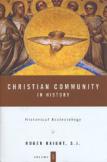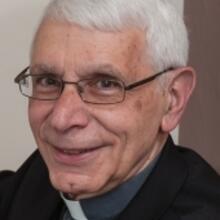Preserving the Church's Identity
Roger Haight, past president of the Catholic Theological Society of America, is one of the most prolific and methodologically astute practitioners of theology today. The present volume, the first of two devoted to the project of “historical ecclesiology,” builds upon the approach to theology he first presented in Dynamics of Theology and further exemplified in his controversial Jesus Symbol of God. A decided pleasure in reading Haight is the clarity of his writing, joined to the precision and systematic rigor with which he mounts and sustains his argument.
Because the present volume will be followed in the spring by “a more systematic and constructive” second volume, the following remarks will, perforce, be provisional. This is all the more the case since the author, announcing the second volume, speaks of “a shift in the tactics by which I carry out the strategy of an ecclesiology from below.”
The first point to note, then, is the interchangeability of the designation of the overall project as either one of “historical ecclesiology” or of “ecclesiology from below.” Though Haight cautions us not to make too much of the designation “from below,” it is clearly of sufficient import for him to dedicate the introduction and first chapter to its clarification and defense.
A first approximation follows: “Against the background of an ecclesiology that is abstract, idealist, and ahistorical, an ecclesiology from below is concrete, realist and historically conscious.” Much of the crucial first chapter fleshes out this methodological option in characteristics set in intentional counterpoint to a classical ecclesiology “from above.”
An ecclesiology from below is sensitive to the contemporary “postmodern” context, marked by historical consciousness and appreciative of pluralism and diversity as a good. It aims to delineate an understanding of church that embraces the entire Christian movement, rather than being narrowly confessional. In harmony with the “anthropological turn” that governs much of modern theology, it tends to appeal to concrete experience rather than invoke unquestioned authorities. It is wary of a “theological reductionism” that risks being docetic and seeks to balance theological reflection with sociological analysis. It opts for a “pneumatocentric,” Spirit-centered approach to church, as one that enables the recognition of real development and legitimate pluralism in church teaching and structures in a way that a more traditionally Christocentric approach to church seemingly fails to accommodate.
Building upon this foundation, Haight proceeds, in the book’s remaining five chapters, to sketch five epochs in the history of the church. He treats successively the church’s genesis, as witnessed in the writings of the New Testament; the pre-Constantinian church of the second and third centuries; the post-Constantinian church through the barbarian invasions; the church in the Middle Ages, with particular focus on the Gregorian Reform under Gregory VII; and the late medieval church, with special attention to the conciliarist movement.
In undertaking this ambitious survey, Haight acknowledges his indebtedness to many specialized historical studies of periods, individuals and movements. Other specialists may take issue with some matters of selection and interpretation. But it is to his great credit to have painstakingly amassed abundant data and intelligently harnessed them for theological purposes. For Haight is not writing church history, but systematic theology. The data, though indispensable, are not sufficient. They are converted to systematic usage through the adept application of properly theological and sociological categories and judgments.
Thus each chapter begins with historical description, but then moves on to social and theological analysis before attempting to cull axioms and principles for the ongoing project of historical ecclesiology. It is this last task that is the particular concern of historical ecclesiology and that will ultimately bear fruit in the comparative and constructive ecclesiology of volume two.
Along the way Haight has drawn some striking sketches. There is a good evocation of Bishop Cyprian’s North African community of the middle of the third century. The Gregorian Reform of the 11th century receives a much more even-handed presentation here than the often truculent treatment accorded it by Hans Küng. Finally, the poignant disarray produced by the late 14th and early 15th century Western schism, when two and even three rival claimants vied for the papal office, sets the scene for an extensive discussion of theologians passionately seeking to resolve the crisis through the summoning of a general council of the church. In each of the foregoing instances one clearly sees reflected, as through a distant mirror, still controverted ecclesiological issues concerning the relation between local and universal church and between papal primacy and episcopal collegiality.
But intriguing and suggestive as these sketches are, Haight’s pioneering project will stand or fall on the cogency of the methodological options and commitments he so carefully delineates. Here I find some grounds for concern. On the one hand, he takes pains to insist that the “from above, from below” approaches are non-polemical constructs and serve only as heuristic devices to clarify tendencies by way of contrast. Yet on the other hand, the systematic pursuit of a “from below” perspective seems uniformly to direct his argument and determine the “principles” he selects for elaboration.
Particularly problematic is the relegation of “Christocentric” to the domain of an ecclesiology “from above,” while the alternative (and preferred) position is a Spirit-centered approach “from below.” Here is how Haight frames the difference. “The risen Christ is located at the center of an ecclesiology from above. And God as Spirit is subordinated in a variety of ways to Christ in this christocentric form of understanding of the church.” By contrast, his own proposal promotes an understanding of church from below whose logic “calls for a pneumatocentrism.” In this approach church is “the community of God as Spirit unleashed into world history in the name of Jesus.”
Admittedly, Haight cautions against hardening the alternatives into a dichotomous either/or. He concedes that “neither Christ-language nor Spirit-language can dispense with the other,” and that the distinction is more “a matter of emphasis” in systematic ecclesiology. But he perceptively adds: “this does not mean that the different emphases do not entail trajectories and consequences; they can make a difference.”
One of the differences it makes surfaces in the assertion that “the structure of an ecclesiology from below places more emphasis on Jesus as the historical source or head of the tradition, the Jesus movement, out of which the church emerged. God’s experienced presence in the community is more spontaneously expressed by the symbol God as Spirit.”
Given such options and persuasions, let me conclude by raising two questions regarding Haight’s ecclesiology in the making. First, does it permit sufficient scope to the present agency of the risen Christ as living Lord of his church? Second, is the tradition’s confession of the church’s Trinitarian foundation adequately served by the consistent and rather undifferentiated appeal to “God as Spirit”? One notes the contrast with the Second Vatican Council’s robustly Trinitarian vision of the mystery of the church. Among the many witnesses to which the council appeals is Cyprian of Carthage. Quoting Cyprian, the council teaches: the church is “a people made one from the unity of Father, Son and Holy Spirit” (Lumen Gentium, No.4).
This article also appeared in print, under the headline “Preserving the Church's Identity,” in the February 7, 2005, issue.








